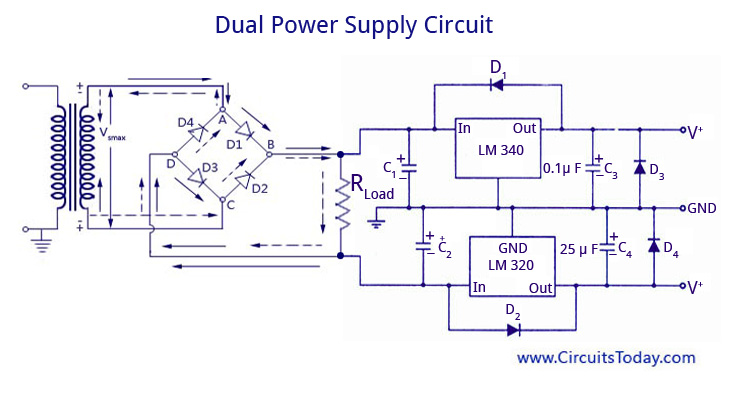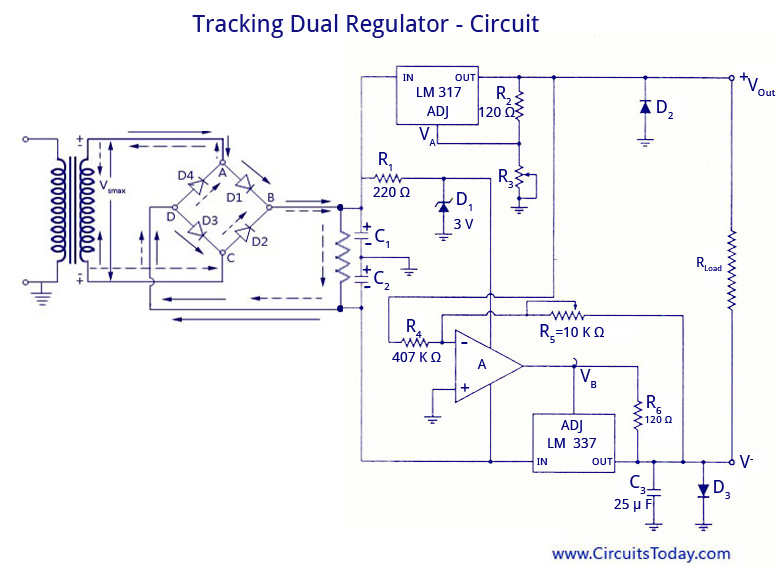Dual Power Supply using LM 320 and LM 340

Bipolar or dual voltage supplies can be easily designed with the help of two 3-terminal regulators. This is shown in the figure above using the IC’s LM320 and LM 340. Opposite-phase ac is provided by the transformer’s secondary and a grounded center tap. The single full-wave bridge converts these into positive and negative dc voltages (with respect to the grounded center tap). The output of the rectifier circuit is filtered with the help of capacitors C1 and C2.
You may also like : Voltage Regulators, IC Voltage Regulators and Regulated Power Supply
While the LM 340 provides regulation of the positive voltage, the LM 320 regulates the negative voltage. It must also be noted that both the IC’s have different pin configurations. The case of the LM 320 is not considered as ground. So special care is to be taken while mounting the negative regulator.
The diodes in the LM circuit are used to provide protection. They ensure that the transient voltages on the regulator outputs do not drive the outputs to a potential above their inputs and cause damage to to the regulators. It must be noted that the diodes are placed as shown in the circuit, and not in the reverse form. The diodes also play an important role in turning on the two regulators simultaneously. If there is a chance of such happening, the output of the slower regulator may be driven toward the potential of the faster one. Thus, the diodes prevent these reverse polarities on start up.

Many applications require several different voltage power supplies. One solution is to build several independent regulators. However, very often it is important that all of these supply voltages track. That is, if one of the supply voltages goes up 2 %, it is best if all of the supply voltages go up by the same amount. It can be accomplished by adding an op-amp to the adjustable three-terminal voltage regulator.
The circuit shown in figure provides current limiting and thermal shutdown for the negative as well as the positive output voltage. The positive regulated voltage is produced with a LM 317 adjustable positive regulator IC, as it was in figure.
The regulated positive voltage is always 1.2 V more positive than the voltage across R3 (on the adjust pin). This regulated output voltage is used as the input of an inverting amplifier. The op-amp A is the input stage of this amplifier, and the LM 337 negative voltage regulator is the power output stage. Consequently, the negative regulated output voltage V” is an amplified and inverted version of the positive regulated voltage V+. Current limiting and thermal shutdown are independently provided by the LM 317 (for the positive output) and the LM 337 (for the negative output). The op-amp assures that the negative output voltage tracks the positive output by driving the LM 337’s adjust pin to + 1.2 V above the required negative output. Since the LM 337 is inside the op-amp’s negative feedback loop, this + 1.2 V offset appears between the op-amp and the regulator, not at the regulator output.

11 Comments
Hi, Thanks for the circuit. In the tracking-dual regulator part, in the third paragraph, “the voltage across R3 (on the adjust pin)” should be “… R5 (…)” ? Thank you!
Beautifull circuit. Thank you for giving the car of the suggested opamp.
C Agie
Brussels
Hi Prashu This is a general circuit. You can adjust both + and – voltages from 1.2 volt to 37 volts at a amaximum of 1.0amp current.
mention watt , volt , ammpear